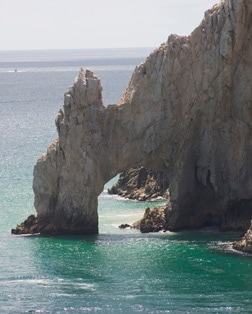
Millennia ago, Cabo San Lucas was part of the Mexican mainland. Then a massive rupture of the San Andreas Fault sent the waters of the Pacific crashing into the newly formed depression, creating the Sea of Cortez and the Baja Peninsula. Lying at the very tip of Baja, where the Pacific meets the Sea of Cortez, Cabo San Lucas - or "Cabo" - is one of the premier resort destinations in the Western Hemisphere. Swim in the transparent waters, marvel at the wealth of marine life, relax on one of the white-sand beaches or try your hand at some of the finest sportfishing in the world.
Port of Cabo San Lucas: An Overview
Cabo San Lucas is an anchor port for all cruises sailing on Mexico's Riviera and Sea of Cortez itineraries, but passengers are a small minority of the tourists who flock there. The heavily Americanized party town serves as one of the most popular beach escapes for Californians and other West Coasters who come here to let loose (spring break festivities are intense and not a proposition for the faint of heart). One of Cabo's major attractions is Cabo Wabo, a cantina owned by rocker Sammy Hagar. Rocks of a different sort -- El Arco, with its jagged points protruding from the Sea of Cortez, make more impressive photos.
Yet for those passing on the beer-pong tournaments and temporary tattoos, Cabo has a lot to offer. Located at the southern tip of the Baja Peninsula, Cabo San Lucas -- together with its more elegant and much quieter sister town of San Jose del Cabo -- is an ideal spot for adventure-oriented pursuits. If conditions are right, the clear waters make for great snorkeling kayaking, stand-up paddleboarding, parasailing, sailing and jet skiing. The Sea of Cortez is among the biologically richest areas in the world, with pods of whales that winter offshore; if you're here in season (late December through late March), a whale-watching trip is a must.
Cabo also has some of the best sportfishing in the world, and it is the quest for marlin that put the town on the map. After World War II and the advent of private planes, Hollywood royalty such as Bing Crosby and John Wayne arrived to fish. In the 1970s, a highway was built to connect California to Baja, and the travel industry began in earnest. Now, it's hard to open a celebrity magazine without seeing photos of A-listers lounging at the six-star resorts that have sprung up in "The Corridor," as the coastal stretch between the two cities is known.
One of the downsides for most cruise travelers: There's no cruise pier, so all ships must anchor and tender passengers to the port. That means you'll need to factor in extra time getting to and from your ship. Even odder is the fact that some ships only stop for half-day visits, which means that actual on-land time can be extremely limited (although excursion providers usually time their tours to meet the needs of cruisers). However, other ships spend two days in Cabo, allowing passengers to stay out until 9 p.m. before the ship maneuvers offshore to open casinos.
Yet for those passing on the beer-pong tournaments and temporary tattoos, Cabo has a lot to offer. Located at the southern tip of the Baja Peninsula, Cabo San Lucas -- together with its more elegant and much quieter sister town of San Jose del Cabo -- is an ideal spot for adventure-oriented pursuits. If conditions are right, the clear waters make for great snorkeling kayaking, stand-up paddleboarding, parasailing, sailing and jet skiing. The Sea of Cortez is among the biologically richest areas in the world, with pods of whales that winter offshore; if you're here in season (late December through late March), a whale-watching trip is a must.
Cabo also has some of the best sportfishing in the world, and it is the quest for marlin that put the town on the map. After World War II and the advent of private planes, Hollywood royalty such as Bing Crosby and John Wayne arrived to fish. In the 1970s, a highway was built to connect California to Baja, and the travel industry began in earnest. Now, it's hard to open a celebrity magazine without seeing photos of A-listers lounging at the six-star resorts that have sprung up in "The Corridor," as the coastal stretch between the two cities is known.
One of the downsides for most cruise travelers: There's no cruise pier, so all ships must anchor and tender passengers to the port. That means you'll need to factor in extra time getting to and from your ship. Even odder is the fact that some ships only stop for half-day visits, which means that actual on-land time can be extremely limited (although excursion providers usually time their tours to meet the needs of cruisers). However, other ships spend two days in Cabo, allowing passengers to stay out until 9 p.m. before the ship maneuvers offshore to open casinos.
No comments:
Post a Comment